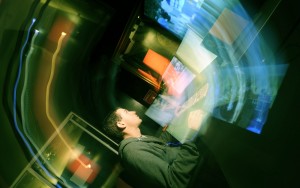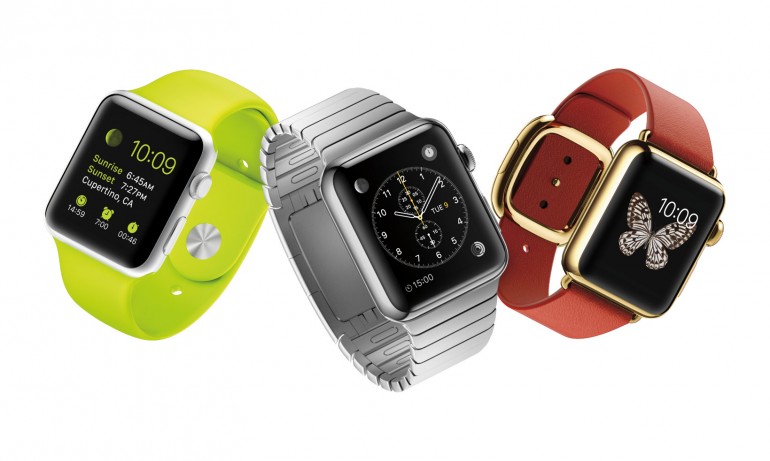
The news industry is currently grappling with a challenging problem: How can it make news interesting to the younger generation?
Virtual reality offers one solution: Strap them in vision-encompassing helmets and let them experience the news like a video game.
The Des Moines Register this fall launched its first experiment with the Oculus Rift, possibly the first major news organization to cover a news story using the 3D virtual reality technology. Reporters from the paper told the immersive story of the evolution of the family farm in its project called Harvest of Change.
The Register and its parent company Gannett hired people to shoot video for the project to appear on 3D in the Oculus Rift, a headset users can strap on to immerse themselves in computer-generated experiences. The project cost about $20,000; the device itself cost $350.
In Harvest of Change, readers can take a tour of the Dammann family farm, which has been passed down in the family for six generations. Viewers can experience how aging, technology, immigration and globalization are changing the farm and interfering with the Dammann livelihood.

Screenshot from The Des Moines Register’s Virtual Reality experiment that told the story of one Iowa farm.
In one instance, the user is transported to the church where the Dammann family usually worships. There, they have access to a full 360-degree view of a church service, while a voiceover explains the importance of religion to the Dammann family.
For those without an Oculus Rift (read: pretty much everybody, as it’s not commercially available yet), there’s also a 2D version available online that plays like a computer game.
The story and its all components drew over 429,000 page views as of Oct. 15, according to Amalie Nash, executive editor and vice president for news and engagement at the Des Moines Register. To put that in perspective, a “pretty good” text story might draw 30,000 views, according to Nash.
Mitch Gelman, vice president/product at Gannett, said he was pleased with the response.
“Oh my god, it’s been much better than I anticipated or ever could have imagined,” said Gelman. “People…were literally blown away by it.”
Nash and Dan Pacheco, a journalism professor at Newhouse School of Public Communications at Syracuse University, said they believed that this was the first time a major news organization experimented with virtual reality.
Gelman said he hatched the idea for using virtual reality to tell news stories after he watched his 15-year-old son play video games. Gelman said he realized that when his son gets older, “he’s not going to pick up the newspaper or sit in front of a television set, he’s going to want a more fully immersive experience based on the way he’s used to engaging with information and entertainment.”
Some months afterwards, Pacheco introduced Gelman to the Oculus Rift. Gelman was hooked.
“I realized this would be a good technology to use to help create nonfiction news content that would potentially grab the attention of a new generation of news consumers,” said Gelman.
The project itself took about three days to shoot and three months to complete, said Nash. It cost somewhere around $20,000, according to Gelman.
That cost includes the one reporter and one photographer from the Register working full time on the project and the four employees from Total Cinema 360 who were helping shoot the 360-degree video and edit the footage. Total Cinema 360 used both GoPro cameras and Google Glass to record the footage, according to the ONA 2014 Student Newsroom.
As for the rift itself, The Des Moines Register purchased it for only $350, said Anthony DeBarros, director of interactive applications at Gannett Digital and the lead author of the virtual reality farm story.
But, out of all the possible applications, why did Gannett choose a farm as the first project?
Credibility, it turns out.
“I was concerned that if we went to the Mardi Gras, or went to a rodeo, or strapped a 3D 360-degree camera on the back of a crocodile wrestler that the industry might come out and say that the very first use of this very important storytelling technology was a gimmick,” said Gelman.
The Dammann family farm was the perfect place for the experiment because it was an example of explanatory journalism, Gelman said.
“Explanatory journalism takes an issue or a subject that all of us are aware of but few of us really understand,” said Gelman. In this instance, it’s how America is changing with the times.
And with the Dammann family farm, they had the perfect human story to anchor the theme to.
Gelman added that now that Harvest of Change has proven the Oculus Rift capable of credible storytelling, he envisions a future where it will be used in situations that have more action than a farm, like “a war zone or a sporting event.”
Nash said that The Des Moines Register is trying to use the Oculus in future projects. Currently, they are trying to incorporate it into a story about agriculture in China, she said.
Nash also mentioned that the Register just bought three Oculus Rifts. She said she could see how they could potentially start regularly incorporating the Rifts into their stories.
Will Other News Organization Try Virtual Reality?
A small number of news organizations are exploring how virtual reality can bring the news to life through 3D interactive experiences.
Media industry experts said journalists have broad possibilities when it comes to virtual reality storytelling. Imagine, for example, letting a reader experience a natural disaster, or watch a live-stream of an international news event, on a 3D headset.
Journalists and industry watchdogs predict more news organizations will follow, though it’s unclear how widespread they will embrace virtual reality storytelling in the coming months.
Gannett, The Des Moines Register parent company, will continue to experiment with virtual reality, Gelman said
“This isn’t the end of the conversation,” DeBarros said. “It’s the beginning of a conversation about how to create more impactful and relevant experiential journalism.”
American Journalism Review contacted more than a half a dozen news organizations for this story to see who else was planning experiments with virtual reality in the coming year, including Vice, The Guardian and The Washington Post.
Of those, BuzzFeed said it is planning on using the Oculus Rift but wouldn’t give any details; the Los Angeles Times said it has only tested it; The New York Times said it doesn’t “have anything to share at this point in time.”
Craig Gilbert, co-founder of Total Cinema 360, the company Gannett hired to shoot the 360-degree video needed for the project, said many more major news organizations have contacted him since The Des Moines Register’s piece was published with hopes of doing something similar. Gilbert would not reveal names.
The journalistic experiments with virtual reality are happening primarily on the Oculus Rift.
It wasn’t until this year that the device started to show some mainstream potential. Facebook recently paid $2 billion to acquire Oculus, the company that developed the Rift.
Facebook CEO Mark Zuckerberg has said that developers are excited for the Rift’s potential in “immersive gaming,” among other applications.
“This really is a new communication platform,” Zuckerberg wrote in a March 25 Facebook post. “Imagine enjoying a court side seat at a game, studying in a classroom of students and teachers all over the world or consulting with a doctor face-to-face – just by putting on goggles in your home.”
Oculus, which hasn’t announced an exact consumer launch date of the Rift, didn’t respond to requests for comment.
Making People Care About the News
Pacheco has visions of how the Oculus could be used in the future.
Maps could be interactive and 3D, said Pacheco.
Pacheco also said natural disaster stories would be perfect for the Oculus Rift, especially when it comes to flooding. He envisions a project where “you can dial in a city, go to one of the coastal areas of that city, and see what the water level is like now and see what it’s like in 10, 20, 30 years.”
“That would be pretty powerful, because instead of reading about the possible effects of climate change, you’re going to be in it,” he said.
Gilbert, from Total Cinema 360, said he would like to see live-stream video incorporated into virtual reality headsets.
“You could do on-site real-time coverage of events,” said Gilbert. “For instance, being able to be in Ferguson when all of that is going down and you’re actually a participant in that environment, you feel as if you’re there, not just for a two-minute period.”
DeBarros said Gannett’s experimentation with virtual reality was important because “the history of journalism as a whole is one of late adoption of technology.” Gannett is doing its best to get ahead of the trends before it achieves mass consumer acceptance, he said.
Gelman said the future of virtual reality in news looks bright, because of the potential for this type of storytelling to inspire empathy among audience, among other benefits.
“It has the chance to make news consumption fun again,” said Gelman.







